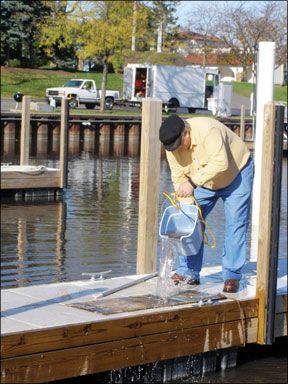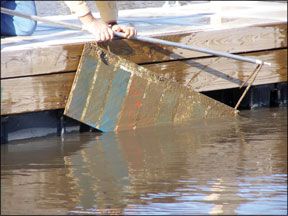Practical Sailors readers have long been asking for a test of antifouling paints in freshwater. Last summer, we sank antifouling paint-covered test panels in Lake Erie, and now, the short-term results are in. The top performers, Pettit Super Premium and Pettit Hydrocoat, are laced with copper, but theyre probably overkill for seasonal boaters. While we havent had much luck in salt water with those low-copper, slick racing paints like Pettit SR-21 and Interlux VC-17M, these freshwater paints hold up well in Lake Erie. *** Temperature and salinity can affect antifouling paint performance, but in our own experience, most modern concoctions are meant to work in a variety of conditions. Those coatings that repel bottom-clingers in the briny waters of the Florida Keys or Long Island Sound (our two test sites) are usually potent enough to deter any freshwater life-form that might try to latch on. 288 Saltwater species exist in one of the harshest, most competitive environments on the planet, and so a great variety of tenacious, fast-reproducing species have evolved. The marine barnacle, the hermaphroditic master-fouler that greatly inspired Charles Darwins larger pursuit, is marvelously well-adapted to thrive in salt water, capable of colonizing an unprotected barge bottom in a single season. Freshwater fouling organisms are no panzies, however. One of the most notorious, the zebra mussel, introduced by the ballast water of voyaging ships, is known to wreak havoc with power-plant cooling systems. However, for sweetwater sailors who have but the summer to sail, the most common threat to the hull is algae. In fact, algae (aka slime) actually tends to grow much faster in fresh water than it does in salt water. Nutrient loading fertilizer runoff is a common source in lakes like Lanier in Georgia, Okeechobee in Florida, or Texoma in Texas and Oklahoma, coupled with summer sun, create ideal conditions for algae blooms. Fortunately, fighting slime alone doesn’t require a lot of copper, a key biocide in most antifouling paints that is driving up costs. One of the best-selling bottom paints in the Midwest, Interlux VC17, has just 17 percent copper. A standout in this test, Pettits SR-21 has just 21 percent copper. In fact, some boaters in Lake Erie, where we dropped our paint panels for the freshwater test, said they do just fine with an annual “moustache,” a 4-foot-wide stripe painted below the waterline (where slime growth is thickest) and finish the entire hull with a multi-season paint every two to three years. Opting for a less-potent concoction in fresh water is more than just economical, it makes environmental sense. Smaller lakes, in particular, are more fragile ecosystems than well-flushed saltwater basins. HOW WERE TESTING Our freshwater evaluation followed our usual, well-established bottom paint test routine. New fiberglass panels were prepped and painted with swatches of various bottom paints. Each panel was identified by a series of holes drilled in a simple binary code. The holes withstand the attack of marine growth better than any other marker system. The system also keeps testers impartial, because they don’t know which paints they are judging. A selection of paints was tested in Lake Erie off Fairport, Ohio. The panels were dropped in mid-July and pulled for rating in late November after 18 weeks in the water. Before assigning ratings, testers sluiced the panels with buckets of water. Virtually clean panels earned Excellent ratings, while Good ratings went to those paints with a minimum of soft growth. Coatings scoring Fair clearly allowed more soft growth than those rated Good. None of the panels in this round showed any hard growth, the criteria for a Poor rating. Once we have the ratings on paper, editors identify overall winners, as well as the top paints in the various categories, such as ablative, hard, multi-season (i.e. does not lose potency when the boat is dry-stored), environmentally friendly, paints for metals, and water-based paints. CONCLUSIONS In general, paints that did well in salt water also did well in fresh water. However, some low-copper paints that did poorly in the saltwater test did very well in fresh water. Top honors overall go to Pettit Super Premium, a copper-loaded paint that had only a few smidgens of slime still clinging to it after being sluiced. The Interlux Ultra was equally clean, but it is more expensive. 288 Shown above is the breakdown for hard paints, which are generally better suited to burnishing or heavy scrubbing, trailering, and beaching. For racers, Pettit SR-21, a thin-film, low-copper paint did much better in fresh water than it did in salt. Almost as effective in our test as the Super Premium (which has three times the amount of copper), SR-21 also sells under the West Marine label as FW-21. For an eco-friendly, copper-free hard paint, EP 2000 is our pick. Metal boats or outdrives are safe with Pettit Vivid, which was also our best hard multi-season paint as well as the best paint available in white or bright colors. For those wanting easy application, Bottomkote Aqua was the best performing water-based hard paint. For those who want a good hard paint for bottom dollar, Pettit Unepoxy Standard is our Budget Buy. In the ablative paint category, our overall winner was Pettit Hydrocoat, an affordable water-based paint that is easy to apply and can be used for multiple seasons. Bluewater, Sea Hawk, and Interlux each had relatively expensive paints that also rated Excellent and so earned our recommendation. For metal boats, Pettit Alumacoat SR is clearly the best ablative. For environmentally friendly protection in an ablative paint, the new copper-free Mission Bay CSF is our top choice. Our Budget Buy in the ablative category is the Pettit Premium SSA, which scored Excellent in our most recent saltwater test in Connecticut. 

Freshwater Antifouling Paints
Were back with our favorite boat maintenance topic: bottom paint. But this time, we put a new spin on it, and tossed some antifouling test panels in fresh water. So if those zebra mussels are getting you down, check out our top picks for bottom paints in fresh water
Also With This Article...

































